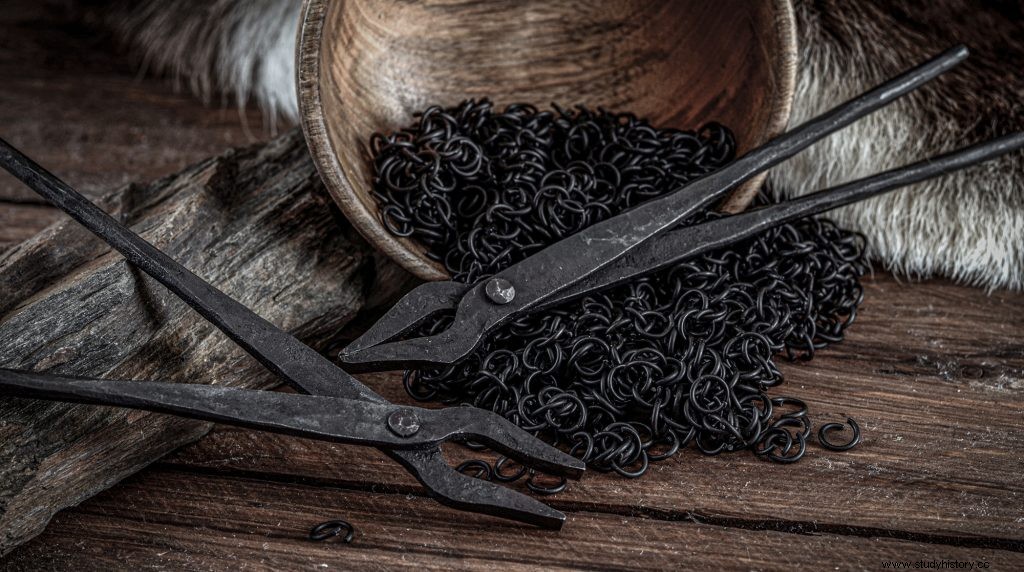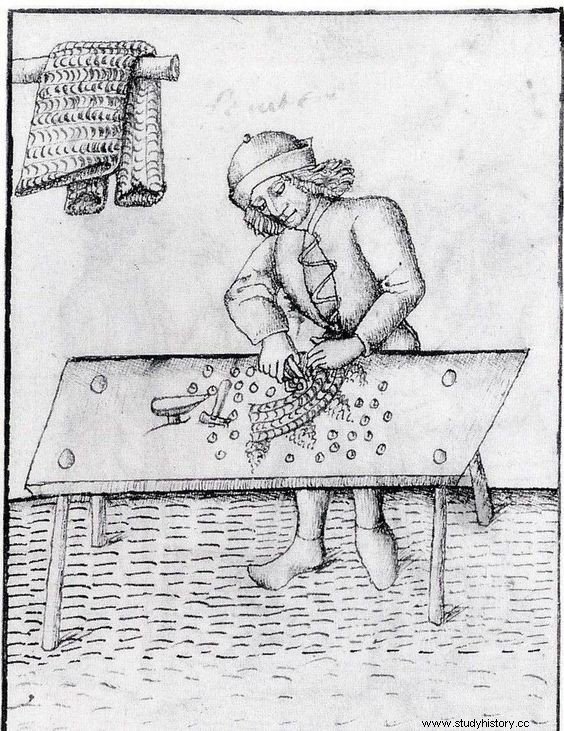The ring armor (chain mail) was worn over many centuries in different variations. Even as full armor armor evolved, it didn't completely disappear from the scene. In this post we take a look at the history of the ring armor.
Before we start, a little note on the terminology: The term "chain mail" is a modern neologism and essentially only includes the armor parts hauberk and haubergeon, i.e. really only upper parts made of chain mail. The term ring armor is more technically correct, especially if it is not defined whether it is a bonnet, a bishop's collar or a chain skirt. We still use the term chainmail from time to time when it's appropriate.
The origin of ring armor
It is not possible to say exactly where the chain mail originally came from. The oldest finds come from the La Tène period and have been dated to the 4th century BC. On the one hand, it is a burial object in present-day Romania and a bog find in present-day Denmark. In the case of the latter, it is assumed that the ring armor represents a sacrifice from the spoils of war, so that the place where it was found does not correspond to the place of manufacture.
A Celtic find from the Bern region is also interesting:the chain mail from Tiefenau, which dates back to around 50 BC. is dated. It is one of the few ring armor finds in Europe that used a 6-in-1 pattern. In addition, the rings are only bent together, i.e. not riveted or stamped. There was also no soldering before or after the restoration of the heavily corroded fragment. One of the fragments is in the Bernisches Historisches Museum and can be examined there.
The mail armor of the Romans
In the 3rd century BC, the Romans adopted this form of armor and called it Lorica Hamata from then on. The poet Cajus Silius describes the ring armor given to Hannibal as a gift in his epic "Punica" as follows:
"Then an armored braid of three-wire ringed gold,
Impenetrable, protect the body from bullets,
Everything, of ore and hardened steel, and with gold of the Tagus
Abundantly connected, the Sidonian looks on with a radiant look
He scrutinizes each one, pleased with the establishment of the home kingdom”
According to Polybius, chain mail was standard equipment for Roman centurions. While leather and plate armor also existed in the Roman army, chain mail was the most popular. Chain mail was worn thigh-length by both the Celts and the Romans. From the 2nd century AD they briefly reached to the waist and had short sleeves. However, this trend did not last long. A century later they were worn knee-length and long-sleeved.
Roman chain mail often features stamped, riveted or welded rings, often in combination. The 4-in-1 technique was used. The Roman warriors probably did not need a denser mesh, as they already enormously strengthened their chain mail with the fastening techniques (riveting, welding and stamping).
With the Roman braid, the rings have a comparatively small inner diameter (ID) of 6 mm. On the one hand, this means that the mesh becomes smaller and therefore more stable. On the other hand, a thinner wire is used for the smaller rings, which means that the ring armor is up to 30% lighter than chain mail with 8 mm ID rings.

Chain armor in the Middle Ages
Mail armor had enormous advantages:it was flexible, relatively light, and required far less metal than plate armor, for example. However, the production also proves to be lengthy. In addition, the braid primarily protected against cuts and less against cuts and stabs. In order to cushion hard blows, warriors therefore wore a padded undergarment under their chain mail. In addition to protecting against broken bones, this extra padding had the effect of preventing broken rings from digging into the skin. However, chain mail with padding was not suitable for defense against arrows and bolts, which is one of the reasons for the triumph of plate armor from the 14th century.
Rings with a diameter of between four and 14 mm were processed in Europe, primarily with the 4-in-1 pattern. A network of small rings is tighter, which increases the protective effect. However, the production of armor with small rings is more tedious, since more rings are required. You can find an overview of common ring types (diameter, clasp, material) in our blog post about chainmail rings.

The craft of the Sarwuker

In the Middle Ages, the so-called Sarwukers were responsible for the production of chain mail. The term comes from Middle High German:sar means as much as armament for war and wuhre means manufacturer. Sarwukers were thus ironsmiths who specialized in the crafting of war armor. Just like the armorers, who devoted themselves to making plate armor, the Sarwukers organized themselves into guilds.
There are very nice depictions of the Sarwuker craft, for example in the house books of the Nuremberg Twelve Brothers Foundation or the manuscript De mulieribus claris (British Library Royal 16 G V, fol. 11) from the early 15th century. Although the latter does not reflect the typical artisan context, it shows quite clearly that the Sarwuker could knot with just a pair of pliers.
